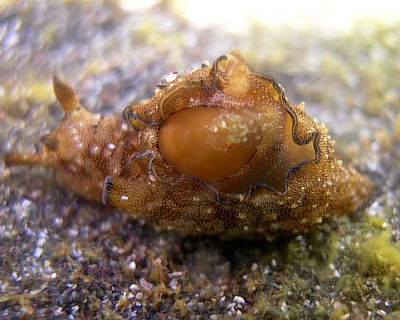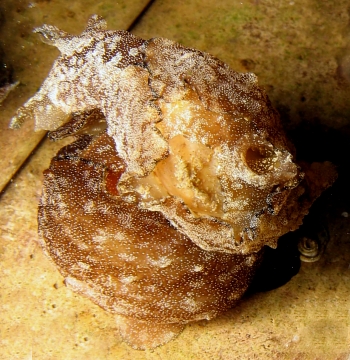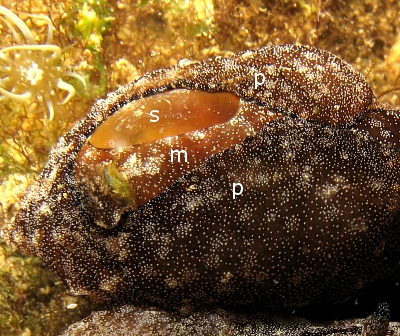Aplysia parvula in Reunion Island
February 1, 2007
From: Philibert Bidgrain


Dear Bill,
We have found some specimens (size: less than 30 mm) of a species which I think are specimens of Aplysia parvula. In the smallest specimen, the border of the parapodia is blue while in the two larger specimens the border of the parapodia is less visible by seems to be black...
Are they able to produce a purple ink?
You say "Aplysia juliana is one of the few species of Aplysia that lacks the ink gland which produces the characteristic reddish purple ink". Is it also true for A parvula?
What's the main difference with A. juliana?
Locality: Saint Gilles, 10 cm, Reunion Island, Indian Ocean, December 2006, lagoon. Photographer: Philibert Bidgrain.
Philibert Bidgrain
http://vieoceane.free.fr/runseaslug/indexslug.htm
pbidgrain@yahoo.fr
Bidgrain, P., 2007 (Feb 1) Aplysia parvula in Reunion Island. [Message in] Sea Slug Forum. Australian Museum, Sydney. Available from http://www.seaslugforum.net/find/19302
Dear Philibert,
Aplysia parvula is a relatively small species which usually has a blackish border to the parapodia. There is another species? or colour form which is black with a whitish border [see Aplysia cf. parvula ]. I am reluctant to give a strict definition of this species because there is so much variability in its colour pattern - or else there are a number if very similar species with slight colour differences. That is why I have many photos of Aplysia parvula and Aplysia cf. parvula on the Forum so you can get a full picture of what we consider at present to be one species. Certainly the colour form in your photos, with tiny white specks, is not an uncommon colour form of the species.
I have included a close-up alongside which shows a very distinctive feature of the species, and that is the very large hole or foramen [= window in Latin] in the mantle, through which we can see, and touch, the brownish shell. [In the photo p = parapodia; m = mantle; s = shell].
A. parvula does indeed produce purple ink, but as I have mentioned elsewhere, it needs to feed on red algae to produce it, and it does not have an endless supply of the ink. If it has recently 'inked' then it needs to feed again to build up another supply of the ink. Apart from the large foramen, black edge to parapodia, size, and inking, it differs from A. juliana in the way it walks along. Aplysia juliana has a peculiar form of crawling, which I described earlier [message #19303], while A. parvula crawls along smoothly like most slugs.
Best wishes,
Bill Rudman
Related messages
-
Aplysia parvula from sthn Queensland
From: Gary Cobb, August 20, 2009 -
Nudibranch? from Bay of Islands, New Zealand
From: Junya Kato, April 3, 2008 -
Aplysia parvula from the Madeira Islands
From: Magno Freitas, February 4, 2008 -
Sea Hare from Indonesia
From: Linda Ianniello, November 23, 2006 -
Hawaiian Aplysia?
From: Sean Kearney, July 20, 2006 -
Aplysia parvula from sthn Queensland
From: Bruce Wilkie, February 10, 2006 -
Please identify this Sea Hare
From: Eileen Baker, February 2, 2006 -
Re: Aplysia parvula - color forms?
From: Asther M. Lau, January 24, 2006 -
Re: More on Aplysia parvula color forms
From: Asther M. Lau, January 24, 2006 -
Aplysia parvula from eastern Russia
From: Alexei Chernyshev , January 12, 2006 -
Aplysia parvula from Halmahera, Indonesia
From: Richard Harlan, June 9, 2005 -
Aplysia parvula laying eggs
From: Dong Bum Koh, May 26, 2005 -
Re: Aplysia parvula - eaten by Nemertine worm
From: Jon Norenburg, May 3, 2005 -
Aplysia parvula - eaten by Nemertine worm [1]
From: Dong Bum Koh, April 29, 2005 -
Aplysia parvula - eaten by Nemertine worm [2]
From: Dong Bum Koh, April 29, 2005 -
Aplysia parvula from Fethiye Bay, Turkey
From: Ant Turkmen, July 15, 2004 -
Aplysia parvula from South Australia
From: Carol van der Pennen, January 15, 2004 -
Colour variation in Aplysia parvula
From: Marina Poddubetskaia, December 16, 2003 -
Food of Aplysia parvula in Mayotte
From: Marina Poddubetskaia, December 16, 2003 -
Re: Other Aplysia parvula from Senegal
From: Marina Poddubetskaia, July 17, 2003 -
Re: Aplysia parvula from Outer Hebrides
From: Jun Imamoto, July 11, 2003 -
Other Aplysia parvula from Senegal
From: Marina Poddubetskaia, July 8, 2003 -
Aplysia parvula from Senegal
From: Marina & Patrice, April 29, 2003 -
Aplysia parvula from Outer Hebrides, Scotland
From: Bill Rudman, April 29, 2003 -
Aplysia parvula from California
From: Bruce Wight, July 29, 2002 -
Mediterranean Aplysia parvula - dwarf male?
From: Marina Poddubetskaia, July 18, 2002 -
More on Aplysia parvula color forms
From: Cory Pittman, July 16, 2002 -
Aplysia parvula - color forms?
From: Scott Johnson, July 9, 2002 -
Aplysia parvula from Korea
From: Dong Bum,Koh, June 28, 2002 -
Aplysia parvula from the Bahamas
From: Anne DuPont, June 8, 2002 -
Re: Aplysia parvula from Bahia de Banderas
From: Alicia Hermosillo, May 9, 2002 -
Aplysia parvula from Bahia de Banderas
From: Alicia Hermosillo, May 6, 2002 -
Aplysia parvula from Sth Africa
From: Valda Fraser, August 9, 2001 -
Re: Juvenile Sea Hare
From: Juan Lucas Cervera, May 18, 2001 -
Juvenile Sea Hare
From: A. Fahrner & M. Schrödl, May 14, 2001 -
Aplysia parvula from Sulawesi
From: Lindsay Warren, August 5, 2000 -
Aplysia punctata or A. parvula?
From: Erwin Koehler, October 18, 1999
